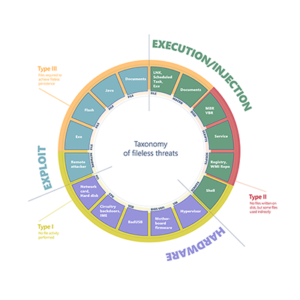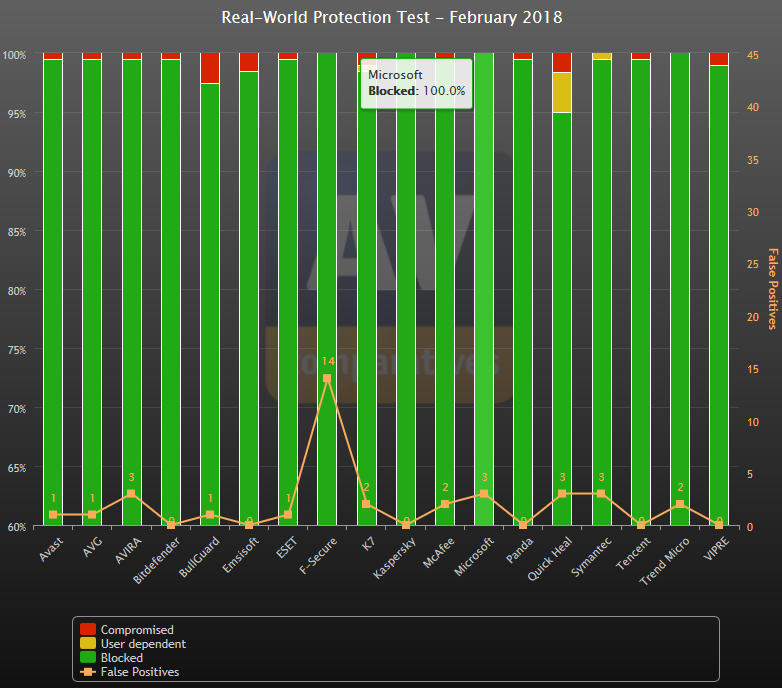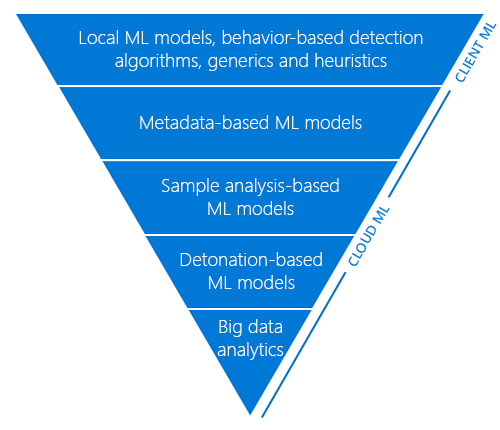(Note: For a comprehensive categorization of fileless malware and a complete list of Microsoft technologies that can protect against these elusive threats, read the latest blog post: Out of sight but not invisible: Defeating fileless malware with behavior monitoring, AMSI, and next-gen AV)
Attackers are determined to circumvent security defenses using increasingly sophisticated techniques. Fileless malware boosts the stealth and effectiveness of an attack, and two of last year’s major ransomware outbreaks (Petya and WannaCry) used fileless techniques as part of their kill chains.
The idea behind fileless malware is simple: If tools already exist on a device (for example PowerShell.exe or wmic.exe) to fulfill an attacker’s objectives, then why drop custom tools that could be flagged as malware? If an attacker can take over a process, run code in its memory space, and then use that code to call tools that are already on a device, the attack becomes more difficult to detect.
Successfully using this approach, sometimes called “living off the land”, is not a walk in the park. There’s another thing that attackers need to deal with: Establishing persistence. Memory is volatile, and with no files on disk, how can attackers get their code to auto-start after a system reboot and retain control of a compromised system?
Misfox: A fileless gateway to victim networks
In April 2016, a customer contacted the Microsoft Incident Response team about a case of cyber-extortion. The attackers had requested a substantial sum of money from the customer in exchange for not releasing their confidential corporate information that the attackers had stolen from the customer’s compromised computers. In addition, the attackers had threatened to “flatten” the network if the customer contacted law enforcement. It was a difficult situation.
Quick fact
Windows Defender AV detections of Misfox more than doubled in Q2 2017 compared to Q1 2017.
|
The Microsoft Incident Response team investigated machines in the network, identified targeted implants, and mapped out the extent of the compromise. The customer was using a well-known third-party antivirus product that was installed on the vast majority of machines. While it was up-to-date with the latest signatures, the AV product had not detected any targeted implants.
The Microsoft team then discovered that the attackers attempted to encrypt files with ransomware twice. Luckily, those attempts failed. As it turned out, the threat to flatten the network was a plan B to monetize the attack after their plan A had failed.
What’s more, the team also discovered that the attackers had covertly persisted in the network for at least seven months through two separate channels:
- The first channel involved a backdoor named Swrort.A that was deployed on several machines; this backdoor was easily detected by antivirus.
- The second channel was much more subtle and interesting, because:
- It did not infect any files on the device
- It left no artifacts on disk
- Common file scanning techniques could not detect it
Should you disable PowerShell?
No. PowerShell is a powerful and secure management tool and is important for many system and IT functions. Attackers use malicious PowerShell scripts as post-exploitation technique that can only take place after an initial compromise has already occurred. Its misuse is a symptom of an attack that begins with other malicious actions like software exploitation, social engineering, or credential theft. The key is to prevent an attacker from getting into the position where they can misuse PowerShell. For tips on mitigating PowerShell abuse, continue reading.
|
The second tool was a strain of fileless malware called Misfox. Once Misfox was running in memory, it:
- Created a registry run key that launches a “one-liner” PowerShell cmdlet
- Launched an obfuscated PowerShell script stored in the registry BLOB; the obfuscated PowerShell script contained a reflective portable executable (PE) loader that loaded a Base64-encoded PE from the registry
Misfox did not drop any executable files, but the script stored in the registry ensured the malware persisted.
Fileless techniques
Misfox exemplifies how cyberattacks can incorporate fileless components in the kill chain. Attackers use several fileless techniques that can make malware implants stealthy and evasive. These techniques include:
- Reflective DLL injection
Reflective DLL injection involves the manual loading of malicious DLLs into a process’ memory without the need for said DLLs to be on disk. The malicious DLL can be hosted on a remote attacker-controlled machine and delivered through a staged network channel (for example, Transport Layer Security (TLS) protocol), or embedded in obfuscated form inside infection vectors like macros and scripts. This results in the evasion of the OS mechanism that monitors and keeps track of loading executable modules. An example of malware that uses Reflective DLL injection is HackTool:Win32/Mikatz!dha.
- Memory exploits
Adversaries use fileless memory exploits to run arbitrary code remotely on victim machines. For example, the UIWIX threat uses the EternalBlue exploit, which was used by both Petya and WannaCry, and has been observed to install the DoublePulsar backdoor, which lives entirely in the kernel’s memory (SMB Dispatch Table). Unlike Petya and Wannacry, UIWIX does not drop any files on disk.
- Script-based techniques
Scripting languages provide powerful means for delivering memory-only executable payloads. Script files can embed encoded shellcodes or binaries that they can decrypt on the fly at run time and execute via .NET objects or directly with APIs without requiring them to be written to disk. The scripts themselves can be hidden in the registry (as in the case of Misfox), read from network streams, or simply run manually in the command-line by an attacker, without ever touching the disk.
- WMI persistence
We’ve seen certain attackers use the Windows Management Instrumentation (WMI) repository to store malicious scripts that are then invoked periodically using WMI bindings. This article [PDF] presents very good examples.
For a detailed list of fileless techniques and categories, visit this comprehensive page on fileless threats.
Fileless malware-specific mitigations on Microsoft 365
Microsoft 365 brings together a set of next-gen security technologies to protect devices, SaaS apps, email, and infrastructure from a wide spectrum of attacks. The following Windows-related components from Microsoft 365 have capabilities to detect and mitigate malware that rely on fileless techniques:
Windows Defender Antivirus
Windows Defender AV blocks the vast majority of malware using generic, heuristic, and behavior-based detections, as well as local and cloud-based machine learning models. Windows Defender AV protects against fileless malware through these capabilities:
- Detecting script-based techniques by leveraging AMSI, which provides the capability to inspect PowerShell and other script types, even with multiple layers of obfuscation
- Detecting and remediating WMI persistence techniques by scanning the WMI repository, both periodically and whenever anomalous behavior is observed
- Detecting reflective DLL injection through enhanced memory scanning techniques and behavioral monitoring
Windows Defender Exploit Guard
Windows Defender Exploit Guard (Windows Defender EG), a new set of host intrusion prevention capabilities, helps reduce the attack surface area by locking down the device against a wide variety of attack vectors. It can help stop attacks that use fileless malware by:
- Mitigating kernel-memory exploits like EternalBlue through Hypervisor Code Integrity (HVCI), which makes it extremely difficult to inject malicious code using kernel-mode software vulnerabilities
- Mitigating user-mode memory exploits through the Exploit protection module, which consists of a number of exploit mitigations that can be applied either at the operating system level or at the individual app level
- Mitigating many script-based fileless techniques, among other techniques, through Attack Surface Reduction (ASR) rules that lock down application behavior
Tip
On top of technical controls, it is important that administrative controls related to people and processes are also in place. The use of fileless techniques that rely on PowerShell and WMI on a remote victim machine requires that the adversary has privileged access to those machines. This may be due to poor administrative practices (for example, configuring a Windows service to run in the context of a domain admin account) that can enable credential theft. Read more about Securing Privileged Access. |
Windows Defender Application Control
Windows Defender Application Control (WDAC) offers a mechanism to enforce strong code Integrity policies and to allow only trusted applications to run. In the context of fileless malware, WDAC locks down PowerShell to Constrained Language Mode, which limits the extended language features that can lead to unverifiable code execution, such as direct .NET scripting, invocation of Win32 APIs via the Add-Type cmdlet, and interaction with COM objects. This essentially mitigates PowerShell-based reflective DLL injection attacks.
Windows Defender Advanced Threat Protection
Windows Defender Advanced Threat Protection (Windows Defender ATP) is the integrated platform for our Windows Endpoint Protection (EPP) and Endpoint Detection and Response (EDR) capabilities. When it comes to post breach scenarios ATP alerts enterprise customers about highly sophisticated and advanced attacks on devices and corporate networks that other preventive protection features have been unable to defend against. It uses rich security data, advanced behavioral analytics, and machine learning to detect such attacks. It can help detect fileless malware in a number of ways, including:
- Exposing covert attacks that use fileless techniques like reflective DLL loading using specific instrumentations that detect abnormal memory allocations
- Detecting script-based fileless attacks by leveraging AMSI, which provides runtime inspection capability into PowerShell and other script-based malware, and applying machine learning models
To test how Windows Defender ATP can help your organization detect, investigate, and respond to advanced attacks, sign up for a free trial.
Microsoft Edge
According to independent security tester NSS Labs, Microsoft Edge blocks more phishing sites and socially engineered malware than other browsers. Microsoft Edge mitigates fileless malware using arbitrary code protection capabilities, which can prevent arbitrary code, including malicious DLLs, from running. This helps mitigate reflective DLL loading attacks. In addition, Microsoft Edge offers a wide array of protections that mitigate threats, fileless or otherwise, using Windows Defender Application Guard integration and Windows Defender SmartScreen.
Windows 10 S
Windows 10 S is a special configuration of Windows 10 that combines many of the security features of Microsoft 365 automatically configured out of the box. It reduces attack surface by only allowing apps from the Microsoft Store. In the context of fileless malware, Windows 10 S has PowerShell Constrained Language Mode enabled by default. In addition, industry-best Microsoft Edge is the default browser, and Hypervisor Code Integrity (HVCI) is enabled by default.
Zaid Arafeh
Senior Program Manager, Windows Defender Research team
Talk to us
Questions, concerns, or insights on this story? Join discussions at the Microsoft community and Windows Defender Security Intelligence.
Follow us on Twitter @WDSecurity and Facebook Windows Defender Security Intelligence.


 Read latest blog post:
Read latest blog post: 


